Trip Report - 8-10-19
It had been a long time since I went on a dedicated micro trip. Coach and I had planned one a few weeks ago, but we found the stream to be high and off color. It would have been impossible to sight fish for micros so after we each caught a few small sunfish we left.
On Saturday I went to a suburban stream that I have fished a few times over the last ten years. I have never seen anyone else fish it. There is a bike path running along the stream for miles. I see lots of cyclists, lots of joggers and a few people just out for a walk but not one angler.
My goal for the day was to compare two versions of the Nikko Sashi, which are artificial fly larvae (fancy name for rubber maggots). The ones I have had in stock for some time are a milky white. I recently received a sample pack of pink ones which are made from a slightly different material.
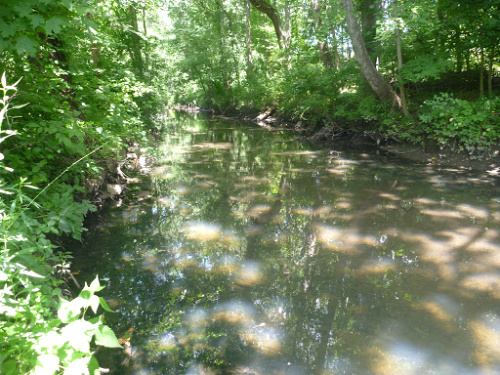 Slow, shallow, and protected by poison ivy
Slow, shallow, and protected by poison ivyThe stream is shallow and has little current in most places. The banks are lined with trees and low foliage - much of which is poison ivy. So, even though the stream has a bike path right alongside, access to the water is pretty limited.
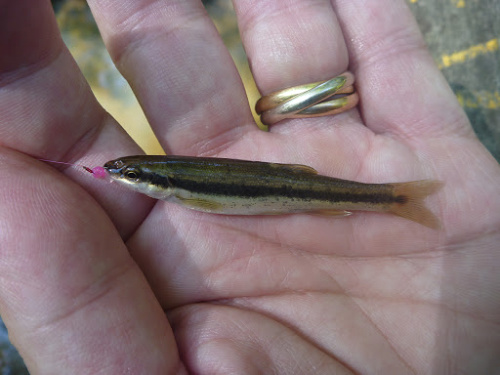 Blacknose Dace
Blacknose DaceI started off with the pink Nikko Sashi, fished with a Gamakatsu Smallest tanago hook, a size 6 Dinsmore shot, some Sunline Visible Free white nylon line and a micro rod constructed from the top five sections of a TenkaraBum 36 and a Winn tenkara grip that I had purchased from tenkaracustoms.com. I had made it before Suntech started making the 6-section Suikei Keiryu Special 27, which was the predecessor of the TenkaraBum Traveler 27.
The first spot where I had reasonable access to the water was from a bridge. Fishing from a bridge allows you to get your line in the water, but not your hands, and not your photo tank. If you catch a fish, you have to unhook it with dry hands.
The Blacknose Dace came quickly. I could see fish from the bridge and all it took was getting the Nikko Sashi reasonably close to one. Initially, I cut the Sashi in half, which is still plenty large enough for the Gamakatsu Smallest hook, and for the Blacknose Dace. Later in the day I used whole Sashi, hooked once crosswise rather than trying to thread it onto the hook. Half or whole, both worked fine.
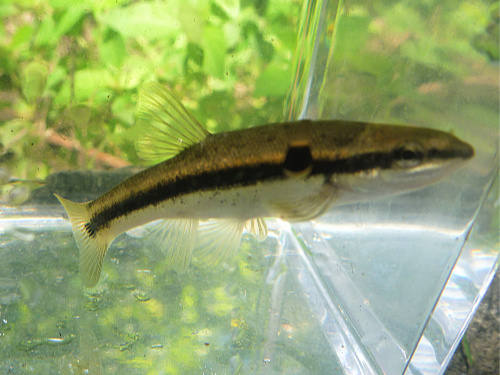 Blacknose Dace
Blacknose DaceAfter walking down the bike path for quite a ways, I found a spot where I could get down the the water to fill my photo tank. It turns out there were Blacknose Dace there as well.
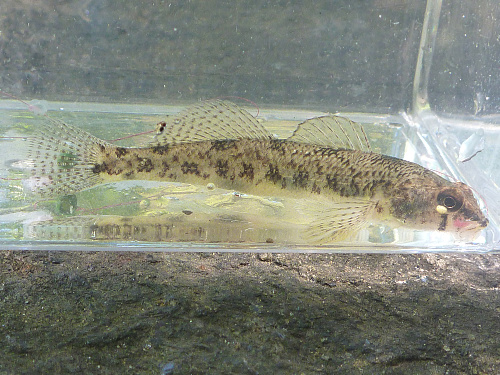 Tessellated Darter
Tessellated DarterDirectly upstream from where I was standing, there was a large branch that had fallen into the water. A log or large branch in the water is often a good spot to fish. It provides a place for the fish to hide and usually also provides some quiet water where fish do not have to fight the current.
Most of my micro fishing is sight fishing. I see the fish and try to get my bait or fly as close to it as possible. The distance to the branch and the position of the sun made sight fishing impossible. It looked like a enough good spot that I thought a few blind casts might be worth it.
If your line is light enough, a micro can make it stop or twitch. On Saturday, I used size 4 nylon, which is lighter than size 2.5 fluorocarbon (and easier to see).
On my first cast, the line stopped, I quickly tightened the line (you need to be quick but you don't need much force to set the hook with micros), and caught my first ever Tessellated Darter. I had seen them many times when trout fishing, but it seems I never saw them when I had brought tanago hooks and something to use for bait. I even once wrote an essay on Micro Fishing Gear: Don't Leave Home Without It but of course, I often did.
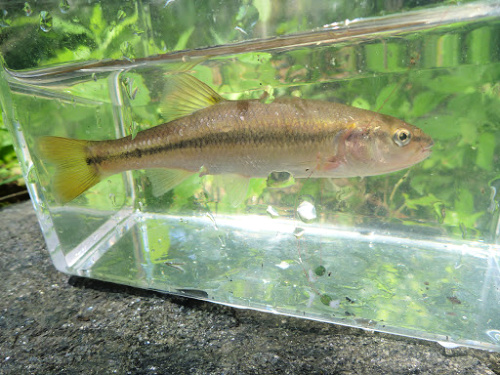 Creek Chub
Creek ChubThat spot also had Creek Chubs. That's not really a surprise. Most streams in the eastern and north central states have creek chubs. They are pretty easy to catch and they fight well for their size. I think they are seriously underrated.
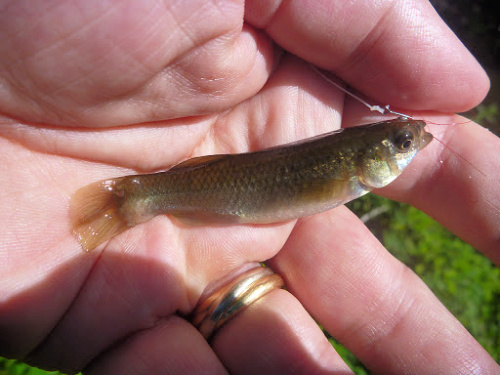 Mummichog
MummichogAt the next spot where I could get close enough to the water to cast the 5-section "micro rod" I saw fish that didn't look like either Blacknose Dace or Tessellated Darters. I couldn't tell what they were until one took the Nikko Sashi.
It turns out the fish were Mummichogs. The stream is tributary to Long Island Sound, and I had once read that the stream had Mummichogs, but I had always assumed that they were only in the brackish water. Where I caught this Mummichog was 15 miles inland and probably 150 feet above sea level.
Unfortunately, even though I could get close enough to cast, I couldn't
get close enough to fill the photo tank or even wet my hands. Damned poison ivy!
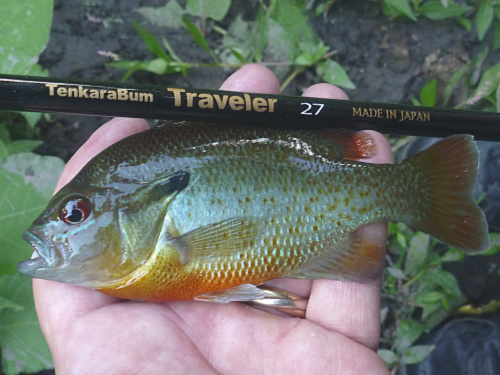 Red Breast Sunfish
Red Breast SunfishThe last fish of the day was a nice Red Breast Sunfish, caught with a TenkaraBum Traveler 27 rather than the top 5 sections of a TenkaraBum 36. The action is similar and to be frank, it makes a lot more sense to just fish a Traveler 27.
I have caught Red Breast Sunfish in other streams in New York and New Jersey, and in Maine lakes, but nowhere are they more colorful than in this particular stream, with bright orange bellies and bright blue sides.
Although the primary goal for the day was to determine whether I prefered the original material for the Nikko Sashi or the new material, I truly couldn't decide. Both worked quite well indeed. Basically, all I had to do was get the Sashi reasonably close to a fish and it usually took it.
Occasionally I was trying to catch a particular fish and a Red Breast Sunfish would streak in from the side to take the Sashi. If I didn't set the hook, after a little bit the fish would spit it out, but then immediately hit it again! That is something I had never seen before. Once, one sunfish took the Sashi, spit it out and then immediately took it again. Then it spit it out again and a second sunfish hit it immediately. Clearly, something about the Nikko Sashi triggers a very powerful response!
Although both versions worked equally well, I will say that I greatly prefer the white color over the pink. It makes it much easier to see the bait, and to see a fish take it. In water that is just deep enough and just murky enough to make it hard to see the fish, I could still see the white Nikko Sashi - and when it suddenly disappeared, it could only be in a fish's mouth.
I caught a bunch of fish and had a nice walk. Not a bad way to spend a Saturday afternoon.
(Oh, I almost forgot to mention that it is a lot easier to keep a package of Nikko Sashi in your vest (along with your tanago hooks) than it is to carry a worm with you just in case you see some micros! Makes it a lot easier to not leave home without micro fishing gear.)
TenkaraBum Home > Microfishing Trip Reports > Trip Report 8-10-19
“The bitterness of poor quality remains long after the sweetness of low price is forgotten” - Benjamin Franklin
"Be sure in casting, that your fly fall first into the water, for if the line fall first, it scares or frightens the fish..." -
Col. Robert Venables 1662
As age slows my pace, I will become more like the heron.
We've all had situations where seriously chewed up flies kept catching fish after fish after fish. It is no sin to tie flies that come off the vise looking seriously chewed up.
Warning:
The hooks are sharp.
The coffee's hot.
The fish are slippery when wet.
Beware of the Dogma
Seriously, all the hooks sold on TenkaraBum.com, whether packaged as loose hooks or incorporated into flies, are sharp - or as Daiichi says on their hook packages, Dangerously Sharp. Some have barbs, which make removal from skin, eyes or clothing difficult. Wear eye protection. Wear a broad-brimmed hat. If you fish with or around children, bend down all hook barbs and make sure the children wear eye protection and broad-brimmed hats. Be aware of your back cast so no one gets hooked.
Also, all the rods sold on TenkaraBum.com will conduct electricity. Do not, under any circumstances, fish during a thunder storm. Consider any fishing rod to be a lightning rod! Fishing rods can and do get hit by lightning!
What's in stock?
Kurenai II AR 30F
Kurenai II AR 33F
Kurenai II AR 39F
TenkaraBum 33
TenkaraBum 36
TenkaraBum 40
Nissin Oni Tenkara Line
Coming Soon
Expected January 13
Furaibo TF39
Furaibo TF39TA
Latest Pages
If you enjoy spin fishing or baitcasting please visit my sister site Finesse-Fishing.com.


